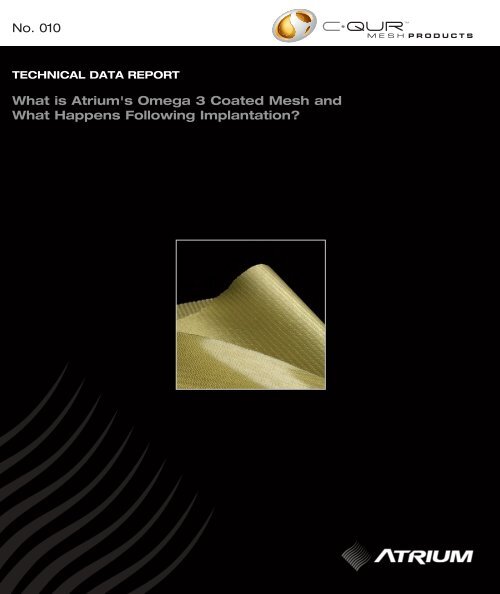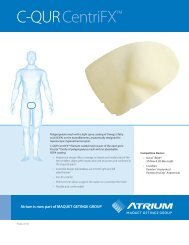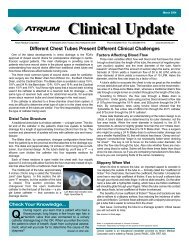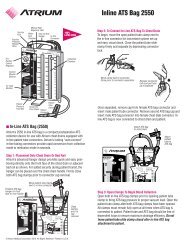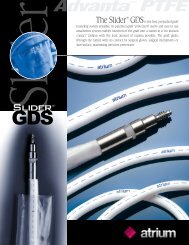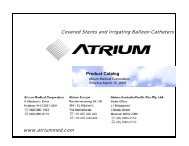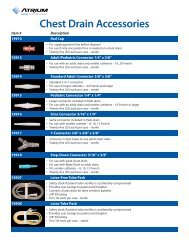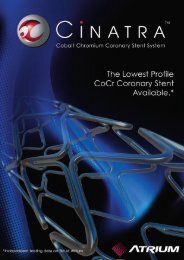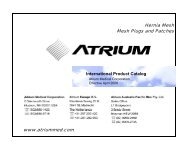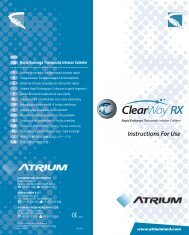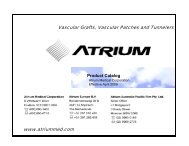No. 010 What is Atrium's Omega 3 Coated Mesh and What Happens ...
No. 010 What is Atrium's Omega 3 Coated Mesh and What Happens ...
No. 010 What is Atrium's Omega 3 Coated Mesh and What Happens ...
Create successful ePaper yourself
Turn your PDF publications into a flip-book with our unique Google optimized e-Paper software.
<strong>No</strong>. <strong>010</strong><br />
TECHNICAL DATA REPORT<br />
<strong>What</strong> <strong>is</strong> <strong>Atrium's</strong> <strong>Omega</strong> 3 <strong>Coated</strong> <strong>Mesh</strong> <strong>and</strong><br />
<strong>What</strong> <strong>Happens</strong> Following Implantation?<br />
PRODUCTS
Technical Data Report<br />
<strong>No</strong>. <strong>010</strong><br />
<strong>What</strong> <strong>is</strong> <strong>Atrium's</strong> <strong>Omega</strong> 3 <strong>Coated</strong> <strong>Mesh</strong><br />
<strong>and</strong> <strong>What</strong> <strong>Happens</strong> Following Implantation?<br />
Coating Technology<br />
Atrium Medical Corporation has developed a<br />
novel coated mesh for intraperitoneal soft t<strong>is</strong>sue<br />
repair. C-QUR <strong>Coated</strong> <strong>Mesh</strong> cons<strong>is</strong>ts<br />
of a lightweight polypropylene mesh material<br />
coated with a bioabsorbable <strong>Omega</strong> 3 fatty<br />
acid cross-linked gel. The <strong>Omega</strong> 3 fatty acid<br />
material cons<strong>is</strong>ts of a blend of mono-, di-, <strong>and</strong><br />
triglycerides <strong>and</strong> fatty acids of various chain<br />
lengths. The fatty acid material <strong>is</strong> a highly<br />
Vimentin Stain<br />
purified pharmaceutical grade, free of contaminants<br />
<strong>and</strong> heavy metals. The <strong>Omega</strong> 3<br />
fatty acid material <strong>is</strong> also free from all allergenic<br />
materials, such as proteins.<br />
The <strong>Omega</strong> 3 fatty acid material <strong>is</strong> formed into<br />
the gel coating through a low temperature<br />
thermal cross-linking process that uses no<br />
H&E Stain<br />
chemical cross-linking agents. The coating<br />
completely covers the polypropylene monofilaments<br />
<strong>and</strong> creates a smooth film surface on<br />
one side of the mesh, providing a t<strong>is</strong>sue separating<br />
layer between the polypropylene mesh<br />
<strong>and</strong> v<strong>is</strong>ceral cavity. The cross-linked fatty<br />
acid gel coating undergoes hydrolys<strong>is</strong> by body<br />
fluids <strong>and</strong> lipase enzymes in vivo, slowly<br />
cleaving the cross-linked bonds. The hydrolys<strong>is</strong><br />
process converts the cross-linked gel<br />
material into naturally occurring fatty acids,<br />
fatty alcohols, <strong>and</strong> glycerides. These smaller<br />
components are readily absorbed by local t<strong>is</strong>sue,<br />
<strong>and</strong> are consumed by normal lipid<br />
metabol<strong>is</strong>m in the mitochondria of the cell for<br />
use in energy production. The bioabsorption<br />
of the coating material leaves lightweight<br />
polypropylene mesh behind as a permanent<br />
repair for the defect.
<strong>What</strong> <strong>Happens</strong> to the Coating?<br />
The semi-solid coating <strong>is</strong> carefully formulated<br />
to provide controlled incorporation <strong>and</strong> penetration<br />
of cellular remodeling as a soft t<strong>is</strong>sue<br />
repair material. Animal studies have shown<br />
resorption of the coating occurring upon<br />
implantation <strong>and</strong> continuing over a 3 to 6<br />
month period. The animal studies indicate<br />
that bio-resorption occurs with decreased<br />
inflammation as evidenced by decreased<br />
presence of mononuclear cells (morphologically<br />
characterized by macrophages <strong>and</strong> foreign<br />
body giant cells) <strong>and</strong> was cons<strong>is</strong>tently<br />
less intense when compared with other commercially<br />
available non-coated polypropylene<br />
mesh.<br />
Excellent t<strong>is</strong>sue incorporation was evident at<br />
all comparable time points to uncoated controls<br />
of Atrium ProLite <strong>and</strong> ProLite Ultra<br />
<strong>Mesh</strong>. In three different animal models (rabbit,<br />
pig <strong>and</strong> rat, hernia patch model, a subcutaneous<br />
implant model, an adipose implant<br />
model, a peritoneal wall implant model), C-<br />
QUR mesh has shown fibrotic t<strong>is</strong>sue incorporation,<br />
specifically on the abdominal wall side<br />
of the implant. The same degree of incorporation<br />
<strong>and</strong> penetration in <strong>and</strong> around the<br />
polypropylene monofilaments was demonstrated<br />
by detailed h<strong>is</strong>tological evaluation <strong>and</strong><br />
testing. Th<strong>is</strong> evidence of encapsulation <strong>and</strong><br />
reinforcement, i.e. not retardation or lack of<br />
fibrotic attachment was advantageous in the<br />
animal model because it promoted wound<br />
defect buttressing <strong>and</strong> healing to the same<br />
degree as other commercially available products.<br />
At the same time there was cons<strong>is</strong>tent<br />
evidence of excellent t<strong>is</strong>sue incorporation<br />
when placed as a patch, spanning an abdominal<br />
wall defect. Evidence of extensive<br />
mesothelial cell coverage was observed with<br />
concomitant reduction in peritoneal adhesions.<br />
The promotion of a mesothelial lining <strong>is</strong><br />
intended to act as a neo-peritoneum to minimize<br />
attachment <strong>and</strong> adhesion of t<strong>is</strong>sues <strong>and</strong><br />
organs. Th<strong>is</strong> was adequately demonstrated in<br />
Lack of Inflammatory Response <strong>and</strong><br />
Incorporation of Monofilament<br />
all animal tests compared to non-coated controls.<br />
The thin semi-solid layer of <strong>Omega</strong> 3 oil did<br />
not impede normal healing or incorporation in<br />
<strong>and</strong> around the individual polypropylene fibers.<br />
At the same time, it demonstrated a membrane<br />
or layering effect (separating adhesiogenic<br />
t<strong>is</strong>sue), reducing inflammation <strong>and</strong> promoting<br />
a slip layer that formed on the peritoneal<br />
cavity side minimizing attachment of<br />
the organs <strong>and</strong> underlying v<strong>is</strong>cera in the peritoneum.<br />
There was no evidence demonstrating<br />
adverse events in these animal studies. It <strong>is</strong><br />
expected that the C-QUR mesh will not<br />
impact adverse events which can occur in the<br />
human condition, such as malignancies,<br />
obstructions, abscess, f<strong>is</strong>tulas, or other<br />
abdominopelvic conditions.<br />
The enclosed h<strong>is</strong>topathology pictures are<br />
incorporated by reference into th<strong>is</strong> description<br />
to demonstrate the adhesiogenic minimizing<br />
layer or membrane effect of the product as<br />
observed in preclinical studies.
TECHNICAL DATA REPORT <strong>No</strong>. 10<br />
Atrium ® © Atrium Medical Corporation 2007. All rights reserved. Printed in U.S.A. 1/07 Part #0054A<br />
Atrium, C-QUR <strong>and</strong> C-QUR Edge are trademarks of Atrium Medical Corporation.<br />
www.atriummed.com


